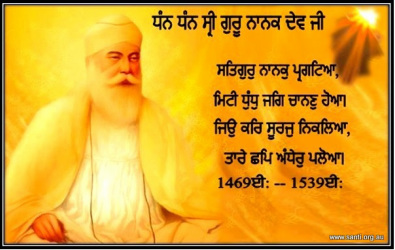 Dhan Guru Nanak Dev Ji
Dhan Guru Nanak Dev Ji
Sikhism's Origin: The Life of Guru Nanak
Dhan Guru Nanak (20 October 1469 - 7 May 1539) is the founder of Sikhism and the first of the ten Sikh Gurus. He was born in the village of Talwandi, now called Nankana Sahib, near Lahore in present-day Pakistan. His parents, Mehta Kalu and Matta Tripat, were Hindus and belonged to the merchant caste. Even as a boy, Nanak was fascinated by religion, and his desire to explore the mysteries of life eventually led him to leave home.
Nanak married a woman named Sulkhni, of Batala; together, they had two sons, Sri Chand and Lakhmi Das. His brother-in-law, the husband of his sister Nanki, got a job for him in Sultanpur as the manager of the government granary, but his employment there wouldn't last long.
One morning, when he was 28 years old, Nanak went (as usual) down to the river to bathe and meditate. It was said that he was gone for three days. When he reappeared, filled with the spirit of God, he said, "There is no Hindu and no Muslim." It was then that he began his missionary work and the religion of Sikhism was born into the world.
Dhan Guru Nanak (20 October 1469 - 7 May 1539) is the founder of Sikhism and the first of the ten Sikh Gurus. He was born in the village of Talwandi, now called Nankana Sahib, near Lahore in present-day Pakistan. His parents, Mehta Kalu and Matta Tripat, were Hindus and belonged to the merchant caste. Even as a boy, Nanak was fascinated by religion, and his desire to explore the mysteries of life eventually led him to leave home.
Nanak married a woman named Sulkhni, of Batala; together, they had two sons, Sri Chand and Lakhmi Das. His brother-in-law, the husband of his sister Nanki, got a job for him in Sultanpur as the manager of the government granary, but his employment there wouldn't last long.
One morning, when he was 28 years old, Nanak went (as usual) down to the river to bathe and meditate. It was said that he was gone for three days. When he reappeared, filled with the spirit of God, he said, "There is no Hindu and no Muslim." It was then that he began his missionary work and the religion of Sikhism was born into the world.
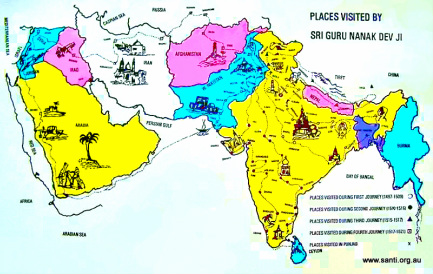 Dhan Guru Nanak Devji's journeys, successors
Dhan Guru Nanak Devji's journeys, successors
Dhan Guru Nanak Devji's journeys, successors
Tradition states that Nanak made four great journeys, traveling to all parts of India, and into Arabia and Persia; visiting Mecca and Baghdad. He spoke before Hindus, Jains, Buddhists, Parsees, and Muslims. He spoke in the temples and mosques, and at various pilgrimage sites. It was during this period that Nanak met Kabir (1441-1518), a saint revered by both Hindus and Muslims.
Wherever he went, Guru Nanak spoke out against empty religious rituals, pilgrimages, the caste system, the sacrifice of widows, of depending on books to learn the true religion, and of all the other tenets that were to define his teachings. Never did he ask his listeners to follow him. He asked the Muslims to be true Muslims and the Hindus to be true Hindus.
Tradition states that Nanak made four great journeys, traveling to all parts of India, and into Arabia and Persia; visiting Mecca and Baghdad. He spoke before Hindus, Jains, Buddhists, Parsees, and Muslims. He spoke in the temples and mosques, and at various pilgrimage sites. It was during this period that Nanak met Kabir (1441-1518), a saint revered by both Hindus and Muslims.
Wherever he went, Guru Nanak spoke out against empty religious rituals, pilgrimages, the caste system, the sacrifice of widows, of depending on books to learn the true religion, and of all the other tenets that were to define his teachings. Never did he ask his listeners to follow him. He asked the Muslims to be true Muslims and the Hindus to be true Hindus.
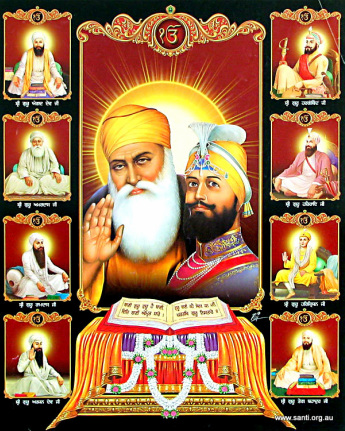 Ten Sikh Gurus
Ten Sikh Gurus
The Ten Gurus
Sikhism was established and developed by ten Gurus during the period 1469 to 1708. Sikhs regard the ten Gurus not as divine, but as enlightened teachers through whom God revealed his will. Each Guru appointed his successor. Guru Nanak Dev was the first Guru and Guru Gobind Singh the final Guru in human form. Guru Gobind Singh designated the Sri Guru Granth Sahib the ultimate and final Sikh Guru.
The Ten Gurus are:
Sikhism was established and developed by ten Gurus during the period 1469 to 1708. Sikhs regard the ten Gurus not as divine, but as enlightened teachers through whom God revealed his will. Each Guru appointed his successor. Guru Nanak Dev was the first Guru and Guru Gobind Singh the final Guru in human form. Guru Gobind Singh designated the Sri Guru Granth Sahib the ultimate and final Sikh Guru.
The Ten Gurus are:
- Guru Nanak Dev (1469-1539). The founder of Sikhism (see above).
- Guru Angad Dev (1504-52). Developed Gurmukhi, the script used for the Punjab language and composed 62 hymns that were later included in the Guru Granth Sahib.
- Guru Amar Das (1479-1574). Became Guru at the age of 73. Organized three annual gatherings for Sikhs, set up the first pilgrimage site at Goindval Sahib and introduced Sikh rituals for birth and death. His most famous hymn, Anand Sahib, is part of Sikh daily ritual.
- Guru Ram Das (1534-1581). Founded Amritsar, the holy city of Sikhism. His followers dug the pool that became the holy lake surrounding the Golden Temple. Composed the Lavan marriage hymn, still used in Sikh marriages.
- Guru Arjan Dev (1563-1606). Collected the hymns of previous Gurus and added 2616 of his own to form the Guru Granth Sahib, the holy book of Sikhism. He also built the Golden Temple.
- Guru Hargobind (1595-1644). The son of Guru Arjan. Proclaimed that the Guru is a military leader as well as spiritual leader, leading to conflict with the Mughal emperor Shah Jahan.
- Guru Har Rai (1630-1661). Grandson of Guru Hargobind.
- Guru Har Krishan (1656-1664). Younger son of Guru Har Rai. Became guru at the age of 5 and died of smallpox at the age of 8. He is the only Guru depicted in art without a beard.
- Guru Tegh Bahadur (1621-75). Great-uncle of Guru Har Krishan. Was barred from Amritsar by Sikh rivals, so founded the Sikh center of Anandpur. Was beheaded in Delhi by Muslims for helping Brahmins avoid forcible conversion to Islam.
- Guru Gobind Singh (1666-1708). Son of Guru Tegh Bahadur. Second only to Guru Nanak in importance, he is often shown prominently next to Nanak in Sikh art. Resisted oppression by Muhgal and Hindu authorities, exemplifying the Sikh ideal of the heroic saint-soldier. Founded the Khalsa and Sikh baptism, composed many poems, and nominated the Sikh sacred text as the final and enduring Guru.
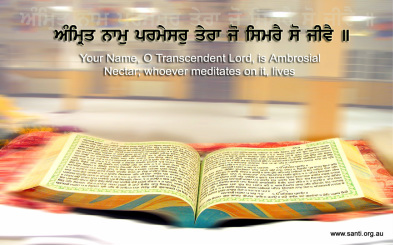 Sri Guru Granth Sahib Ji
Sri Guru Granth Sahib Ji
Present Sikh Guru - Guru Granth Sahib Ji
Guru Granth Sahib Ji, is the central religious text of Sikhism, considered by Sikhs to be the final sovereign Guru of the religion. It is a voluminous text of 1430 Angs (pages), compiled and composed during the period of Sikh gurus, from 1469 to 1708. It is a collection of hymns (Shabad) or Baani describing the qualities of God and why one should meditate on God's naam. Guru Gobind Singh (1666–1708), the tenth guru, after adding Guru Tegh Bahadur's bani to the Adi Granth affirmed the sacred text as his successor, elevating it to Guru Granth Sahib Ji. The text remains the holy scripture of the Sikhs, regarded as the teachings of the Ten Gurus. The role of Guru Granth Sahib Ji, as a source or guide of prayer, is pivotal in Sikh worship. The Adi Granth, the first rendition, was first compiled by the fifth Sikh guru, Guru Arjun (1563–1606), from hymns of the first five Sikh gurus and 15 other great saints, or bhagats, including those of the Hindu and Muslim faith. Guru Gobind Singh Ji, the tenth Sikh guru added all 115 of Guru Tegh Bahadur's hymns to the Adi Granth and this second rendition became known as Guru Granth Sahib Ji. After the tenth Sikh guru died many copies were prepared for distribution by Baba Deep Singh Ji and Bhai Mani Singh Ji.
It is written in the Gurmukhī script, in various dialects – including Lehndi Punjabi, Braj Bhasha, Khariboli, Sanskrit and Persian – often coalesced under the generic title of Sant Language.
Guru Granth Sahib Ji, is the central religious text of Sikhism, considered by Sikhs to be the final sovereign Guru of the religion. It is a voluminous text of 1430 Angs (pages), compiled and composed during the period of Sikh gurus, from 1469 to 1708. It is a collection of hymns (Shabad) or Baani describing the qualities of God and why one should meditate on God's naam. Guru Gobind Singh (1666–1708), the tenth guru, after adding Guru Tegh Bahadur's bani to the Adi Granth affirmed the sacred text as his successor, elevating it to Guru Granth Sahib Ji. The text remains the holy scripture of the Sikhs, regarded as the teachings of the Ten Gurus. The role of Guru Granth Sahib Ji, as a source or guide of prayer, is pivotal in Sikh worship. The Adi Granth, the first rendition, was first compiled by the fifth Sikh guru, Guru Arjun (1563–1606), from hymns of the first five Sikh gurus and 15 other great saints, or bhagats, including those of the Hindu and Muslim faith. Guru Gobind Singh Ji, the tenth Sikh guru added all 115 of Guru Tegh Bahadur's hymns to the Adi Granth and this second rendition became known as Guru Granth Sahib Ji. After the tenth Sikh guru died many copies were prepared for distribution by Baba Deep Singh Ji and Bhai Mani Singh Ji.
It is written in the Gurmukhī script, in various dialects – including Lehndi Punjabi, Braj Bhasha, Khariboli, Sanskrit and Persian – often coalesced under the generic title of Sant Language.
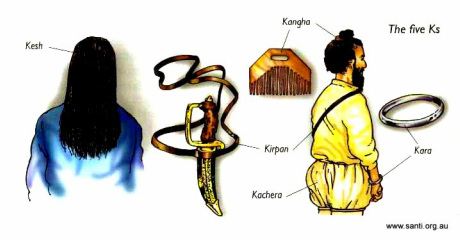 The Sikh Symbols - The Five K's
The Sikh Symbols - The Five K's
The Sikh Symbols - The Five K's
Kesh
Kirpan
Kesh
- Uncut hair, which is kept covered by a turban, or dastaar.
- Kesh are a traditional symbol of holiness in India, and the turban is a symbol of leadership.
- The dastaar is worn by men and some women to cover their long hair.
Kirpan
- A ceremonial sword, symbolizing readiness to protect the weak, and defend against injustice and persecution.
- The kirpan is normally worn with a cloth shoulder strap called a gatra.
- The kirpan exemplifies the warrior character of a Sikh.
- A steel bracelet, symbolizing strength and integrity.
- Steel is symbolic of strength yet resilient under stress. In the same way, the human soul must become as strong and unbreakable as steel which has been tempered in the furnace.
- A small wooden comb, symbolizing cleanliness and order.
- The kangha is used to keep the hair clean and is normally tucked neatly in one's uncut hair.
- As a Sikh combs their hair daily, he or she should also comb their mind with the Guru's wisdom.
- Cotton boxer shorts, symbolizing self-control and chastity; prohibition of adultery.
